
Security News
Node.js EOL Versions CVE Dubbed the "Worst CVE of the Year" by Security Experts
Critics call the Node.js EOL CVE a misuse of the system, sparking debate over CVE standards and the growing noise in vulnerability databases.
@arilotter/tsne-js
Advanced tools
t-distributed stochastic neighbor embedding (t-SNE) algorithm implemented in JavaScript
Runs in the browser (also runs in Web Workers)
Runs in node.js
Uses efficient in-place matrix operations via ndarray
Follows closely the API of scikit-learn, allowing specification of perplexity and early exaggeration factor, among other parameters.
t-SNE is a powerful manifold technique for embedding data into low-dimensional space (typically 2-d or 3-d for visualization purposes) while preserving small pairwise distances or local data structures in the original high-dimensional space. In practice, this results in a much more intuitive layout within the low-dimensional space as compared to other techniques. The low-dimensional embedding is learned by minimizing the Kullback-Leibler divergence between the pairwise-similarity probability distribution over the original data space and distribution over the embedding space.
An important note is that the objective function is non-convex with numerous local minima, and thus the results are non-deterministic. There are a few model parameters which influence the learning and optimization process. Selecting appropriate parameters for the input data can significantly improve the chances the model converge on good solutions.
Currently implemented is the exact fomulation, which has computational complexity O(dN^2), where d is the original dimensionality of the data and N is the number of samples. Implementation of the O(dN*logN) Barnes-Hut approximation variant is planned (contributions welcome!).

Can be run in node.js or the browser. In the browser, should ideally be run in a web worker.
$ npm install tsne-js --save
import TSNE from 'tsne-js';
let model = new TSNE({
dim: 2,
perplexity: 30.0,
earlyExaggeration: 4.0,
learningRate: 100.0,
nIter: 1000,
metric: 'euclidean'
});
// inputData is a nested array which can be converted into an ndarray
// alternatively, it can be an array of coordinates (second argument should be specified as 'sparse')
model.init({
data: inputData,
type: 'dense'
});
// `error`, `iter`: final error and iteration number
// note: computation-heavy action happens here
let [error, iter] = model.run();
// rerun without re-calculating pairwise distances, etc.
let [error, iter] = model.rerun();
// `output` is unpacked ndarray (regular nested javascript array)
let output = model.getOutput();
// `outputScaled` is `output` scaled to a range of [-1, 1]
let outputScaled = model.getOutputScaled();
<script src="tsne.min.js"></script>
Then it's the same API as above. A browser example using Web Workers is in the example/ folder.
dim: number of embedding dimensions, typically 2 or 3
perplexity: approximately related to number of nearest neighbors used during learning, typically between 5 and 50
earlyExaggeration: parameter which influences spacing between clusters, must be at least 1.0
learningRate: learning rate for gradient descent, typically between 100 and 1000
nIter: maximum number of iterations, should be at least 200
metric: distance measure to use for input data, currently implemented measures include
'euclidean''manhattan''jaccard' (boolean data)'dice' (boolean data)You can also pass a distance function to metric
import cwise from 'cwise';
// Operates on an n-dimensional array using the cwise module
let euclidean = cwise({
args: ['array', 'array'],
pre: function(a, b) {
this.sum = 0.0;
},
body: function(a, b) {
var d = a - b;
this.sum += d * d;
},
post: function(a, b) {
return Math.sqrt(this.sum);
}
});
let model = new TSNE({
metric: euclidean
});
To run build yourself, for both the browser (outputs to build/tsne.min.js) and node.js (outputs to dist/):
$ npm run build
To build for just the browser, run npm run build-browser, and to build for just node.js, run npm run build-node.
$ npm test
The original paper on t-SNE:
L.J.P. van der Maaten and G.E. Hinton.
Visualizing High-Dimensional Data Using t-SNE.
Journal of Machine Learning Research 9(Nov):2579-2605, 2008.
Paper on Barnes-Hut variant t-SNE:
L.J.P. van der Maaten.
Accelerating t-SNE using Tree-Based Algorithms.
Journal of Machine Learning Research 15(Oct):3221-3245, 2014.
FAQs
t-SNE implementation in JavaScript
The npm package @arilotter/tsne-js receives a total of 1 weekly downloads. As such, @arilotter/tsne-js popularity was classified as not popular.
We found that @arilotter/tsne-js demonstrated a not healthy version release cadence and project activity because the last version was released a year ago. It has 1 open source maintainer collaborating on the project.
Did you know?

Socket for GitHub automatically highlights issues in each pull request and monitors the health of all your open source dependencies. Discover the contents of your packages and block harmful activity before you install or update your dependencies.

Security News
Critics call the Node.js EOL CVE a misuse of the system, sparking debate over CVE standards and the growing noise in vulnerability databases.

Security News
cURL and Go security teams are publicly rejecting CVSS as flawed for assessing vulnerabilities and are calling for more accurate, context-aware approaches.

Security News
Bun 1.2 enhances its JavaScript runtime with 90% Node.js compatibility, built-in S3 and Postgres support, HTML Imports, and faster, cloud-first performance.